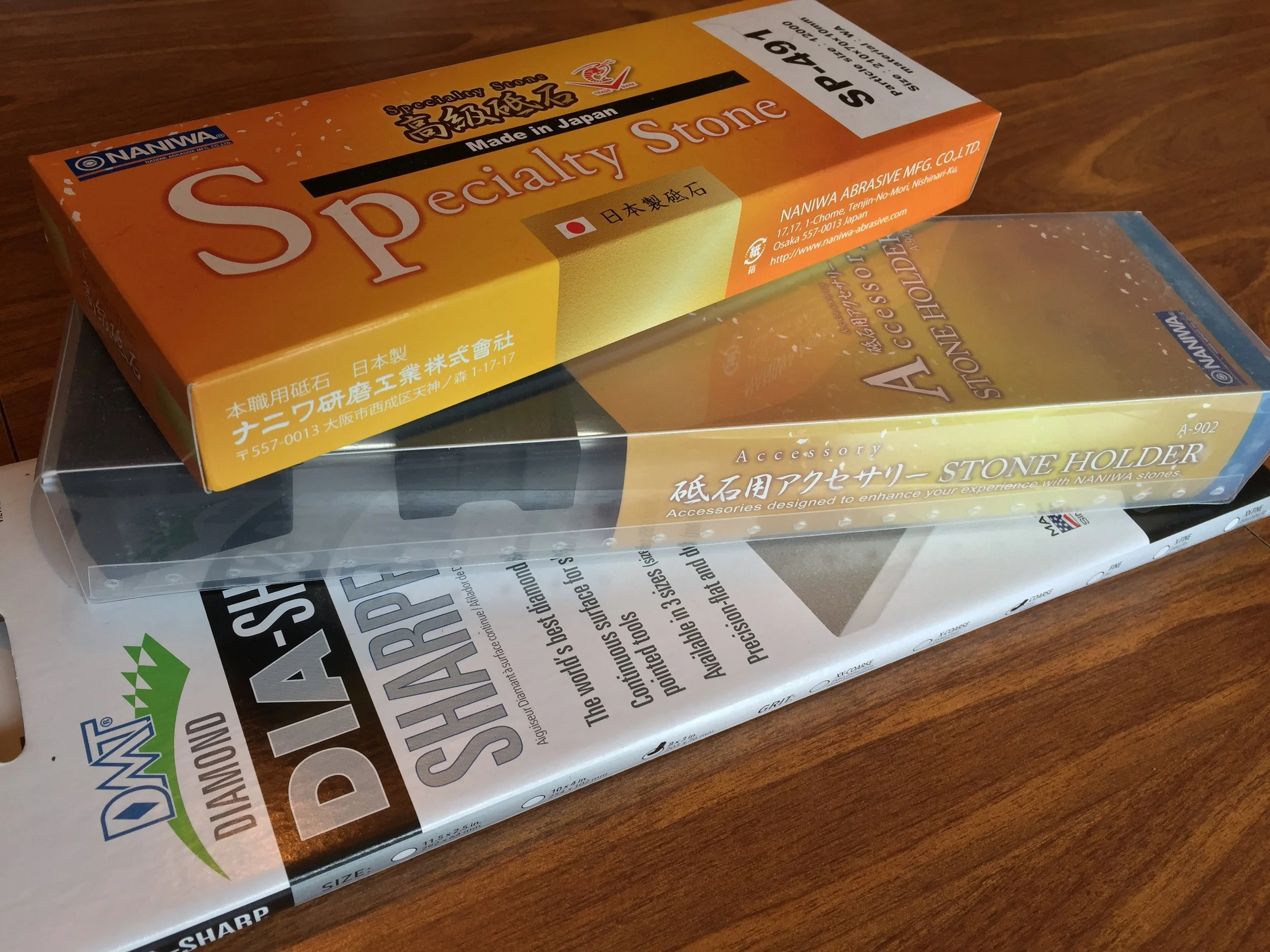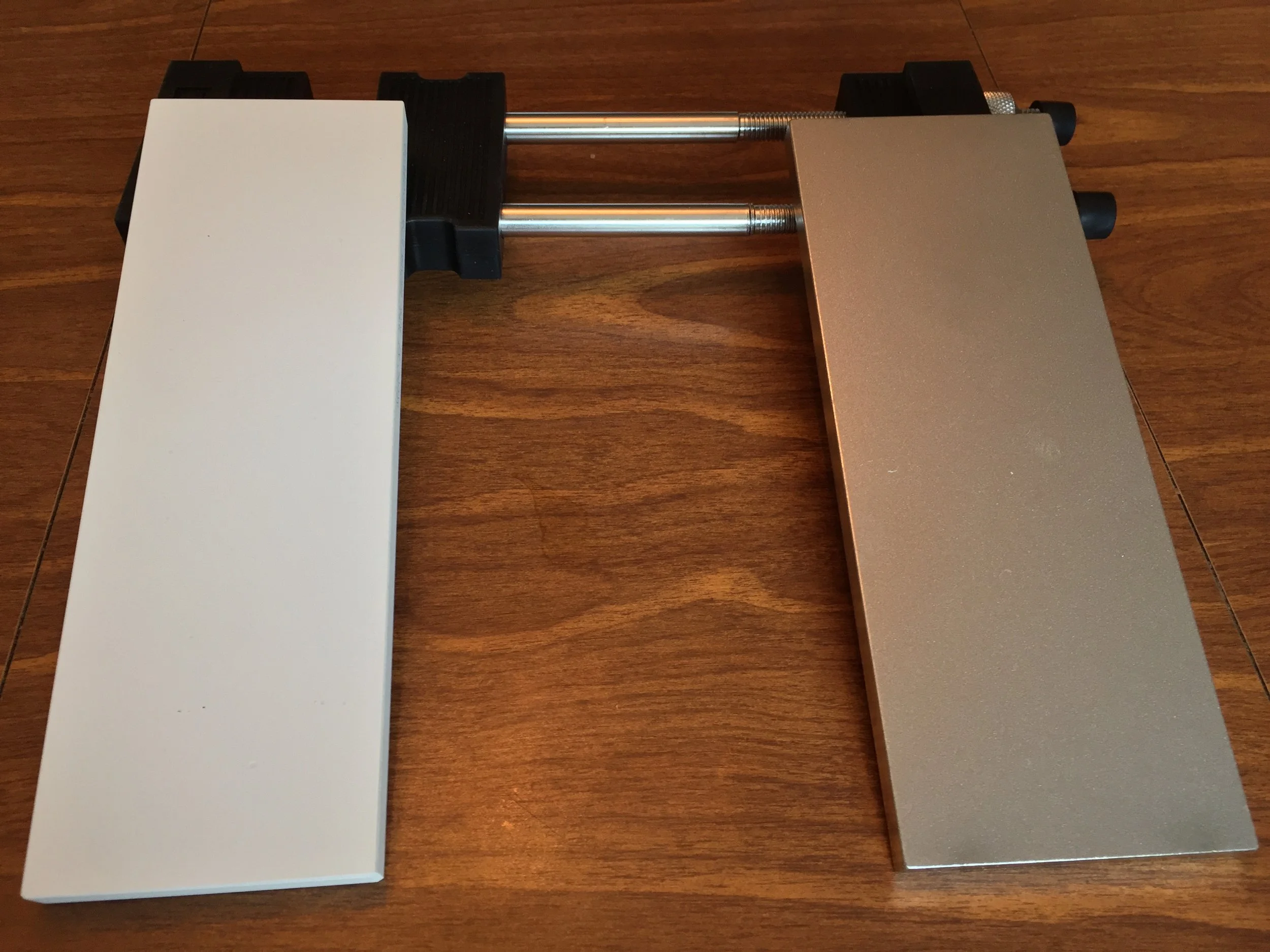Review: Naniwa 12,000K Stone and DMT-325C Lapping Plate
(2017) Welcome to the end of No-Shave November, the fundraiser for cancer where men donate the money saved on shaving supplies to charity. With the cycling world (albeit with a few exceptions) more accepting of the five o’clock shadow and onward, this shaving article may be of service to those who are excited to sharpen up the lines on the face and return to stubble-free living. Though with the weekend fast approaching, this may be something to save for Sunday to take advantage of the facial flannel during cold weekend rides.
Let’s imagine you have gone quite some time without servicing your straight razor. In previous article we have discussed the importance of having a leather strop to keep a keen edge on your blade. We also added the benefits of slathering the linen side of your strop with chromium oxide. The pre- shave process looks something like: twenty laps on the paste strop, twenty-five laps on the clean linen side, and fifty laps on the leather. But despite doing all these efforts, at some point you will have to get more aggressive with the razor. Stropping doesn’t prevent dulling.
What follows next is a lesson in determination. One could send the razor away to Portland Razor Company and get it professionally honed and polished for an impressive twenty dollars. The only downside to this process is being without your straight razor for a spell. We have stressed the economics of wet shaving with a straight razor so we will assume the household only has one razor. One great alternative to returning to cartridges is a shavette, particularly by Dreadnought for twenty bucks.
The alternative is to purchase stones and learn to do it yourself.
In parts one and two of our feature about wet shaving, we talked about how the hobby would get out of hand. It all started with a curiosity in simplicity. In came the straight razor and off went the facial fuzz and undoubtedly a small donation of blood. The next curiosity turned to looking cool with the fuzzy brush and puffy cloud of shave cream. “I’ll stop there,” you may have thought only to find yourself on another shave cream site ready to verify the purchase. The strop followed, along with the aftershave, shave towels, styptic pencil, and wall mounted shave mirror. Now your straight razor feels like it is ripping the hair out of your face instead of slicing it off. Time to refresh the blade. Here are three products to help you with just that.
Naniwa 12,000-Grit Super Stone ($90 USD)
We will start with something that resembles ceramic. The Naniwa 12K grit superstone has evolved recently. It is a synthetic superstone that no longer comes with a base (we’ll touch on that next). This stone is extremely dense from resin bonding and takes on the appearance of a single sheet of shiny clay. Another update to the stone is that it no longer needs to be soaked prior to use. Now all one needs to do is spray the surface to form small puddle and the quick trips can commence. Since the 12K stone is the top of the pyramid for sharpening, the laps necessary are few. Most experts recommend between ten and twenty laps to get the edge you have been missing.
Since this is the finest of the Naniwa stones it is also the most expensive. The higher the grit, the higher the price. With many options for finishing stones on the market, the Naniwa is heavily leaned on for its consistency. Since it is not a natural stone, it is manufactured with an eye on consistency. Natural stones are difficult to work with and mostly a contention of pride for those who use them. But really, why make the job harder than it is? Since you’re reading this portion of the article, it is assumed you are researching your first stone. Consistency is can build confidence. One other option is to try your hand at honing before mailing it out to Portland Razor Company for a professional sharpening. If they call you and say, “This is already sharp” you know you’ve done a decent job. Utilize some trustworthy YouTube videos to get tips from noteworthy experts before you start.
From left to right: The Naniwa 12k grit sharpening stone, the Naniwa Sharpening Stone Holder, the DMT D8C 325 Diamond Lapping plate.
Naniwa Sharpening Stone Holder ($20)
Naniwa’s stones used to come with a plastic holder built in. The problem was if one of the legs busted off, what then? The cheapest part of the stone now made it nearly impossible to use. This problem was solved by the Naniwa Sharpening Stone Holder.
It is extremely easy to use. Take the aforementioned Naniwa 12K grit stone and place it between the rubber holders. Adjust the middle rubber holder to the beneath the center of your stone. Using the two chrome plated screws tighten the holders until the stone is locked in place. The stone holder can take a stone as short as 6.5 inches up to 8.5 inches. It is a simple accessory that needs to be purchased with any sharpening stone. There are other options on the market, such as one that can span a sink, but this one is the simplest. Again, simple is better.
DMT D8C 325 Diamond Lapping Stone ($65)
Strangely in this world of simplicity there is a bit of confusion. Prior to using the Naniwa 12K grit stone, it must be lapped, or rubbed with a course stone. Therefore one needs to buy another stone to smooth out the first one. But there’s a silver lining to owning a DMT D8C 325 diamond stone.
The first order of business is to take the Naniwa 12K stone and score its surface with a series of pencil marks. Under running water take the two stones and rub them together with minimal pressure. Once the pencil marks have disappeared, the Naniwa stone is ready for service. The DMT is also ready for service once you have rinsed the surface of any residue from the 12K stone and once you have diverted your attention from straight razor honing. It is a heavy stone but it isn’t the biggest lapping stone on the market. Because of this, take special care to focus on the edges of the 12K stone when lapping it. I can sense the frustration one might have of realizing the necessity of purchasing another piece just to maintain a razor priding itself on simplicity. As a matter of fact, more stones over time will need to be added to the mix. But for now consider the second purpose of the DMT D8C 325 diamond lapping plate.
It has been more than ten years since I have sharpened my kitchen cutlery. I doubt I need to mention that is much too long. How I still have my fingers after the cutting blade has slid off of an onion I don’t know. Once I refreshed my straight razor blade I grabbed the knife block and went to work. Suddenly the chef’s knife was mean again. The steak knives could actually cut through steak. The paring knife was back to its old self. This stone just paid for itself, and it fit right into the Naniwa Sharpening Stone Holder.
Well. There you have it: a crash course in some of the stones needed to bring back the razor gusto in anticipation to remove the month long beard that has crept along the face. We will be back with reviews on the next stones we add to the collection as well as our experience with Portland Razor Company’s honing service. We could throw these up on the holiday gift list, or they would make a great ninth wedding anniversary gift since ceramic is the modern day ninth anniversary gift. How nice.
Back to the offseason cycling.





